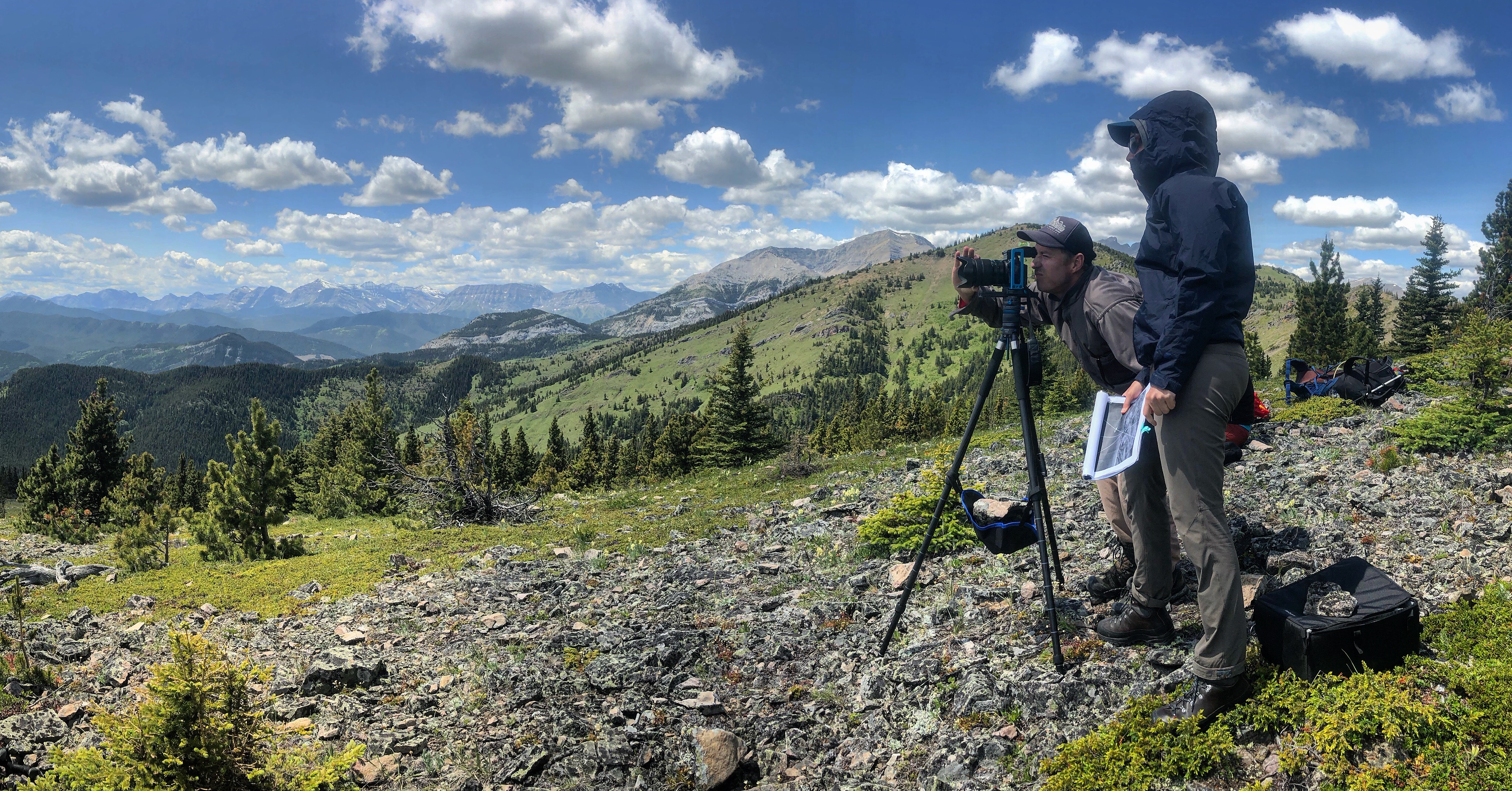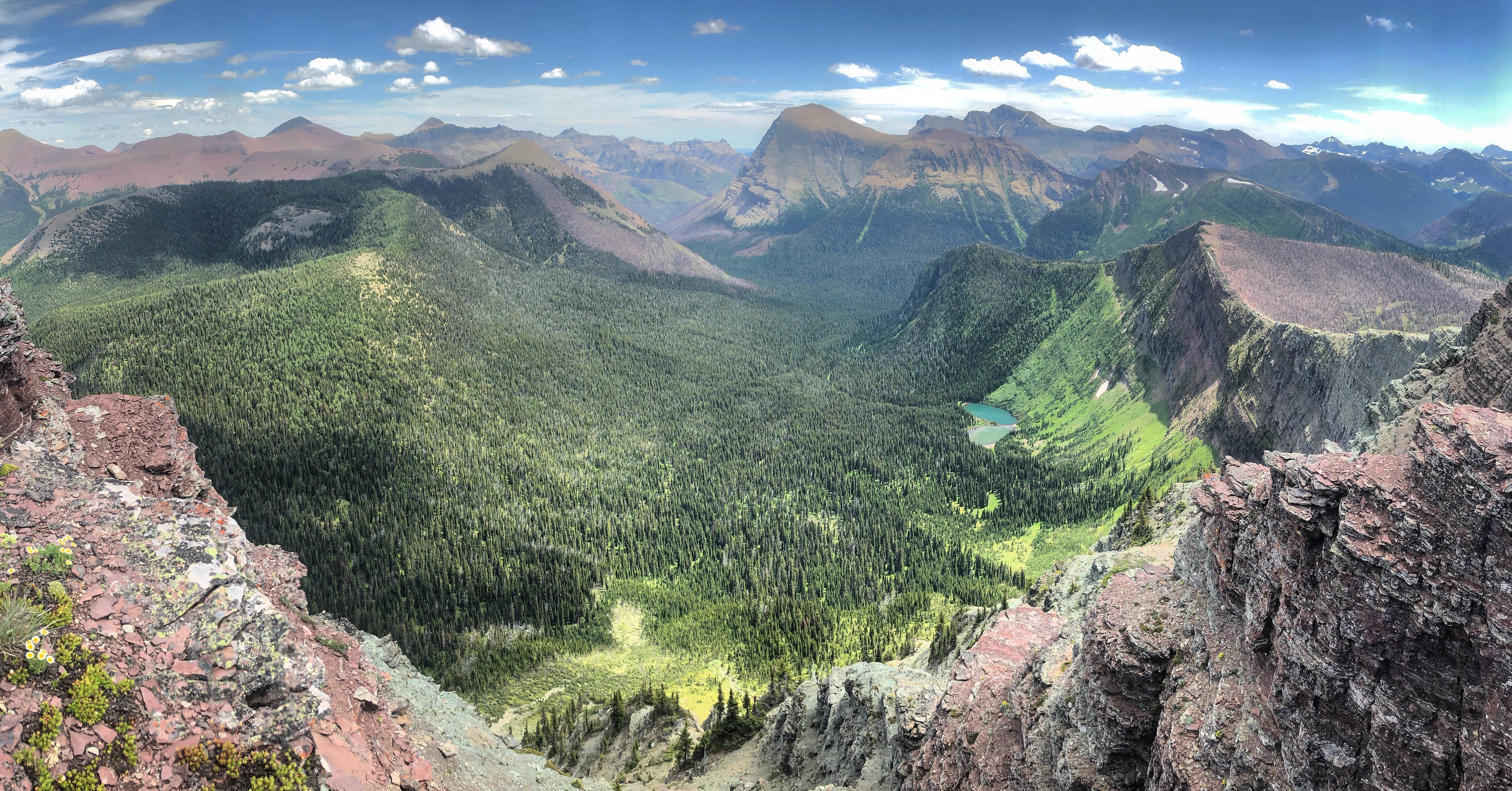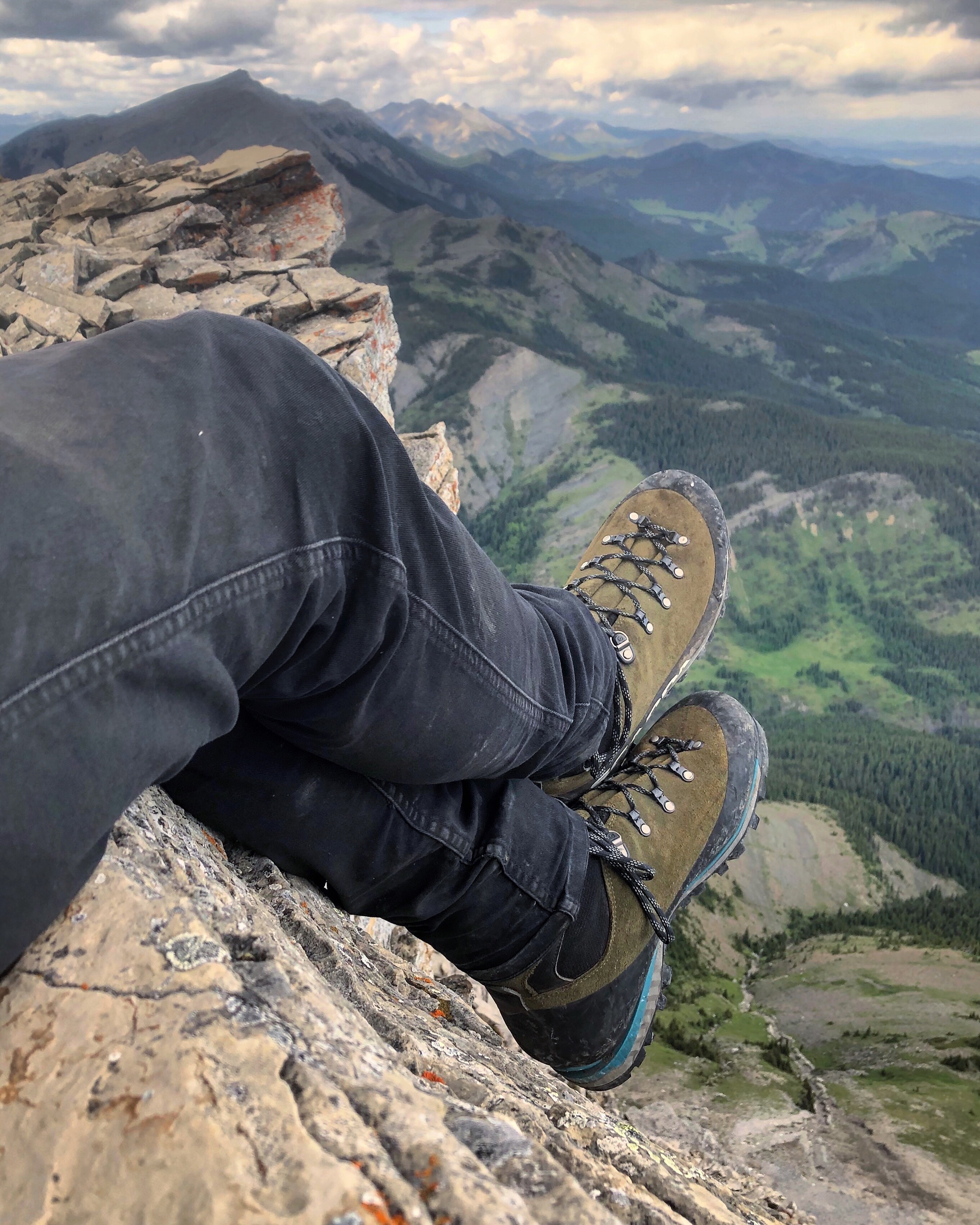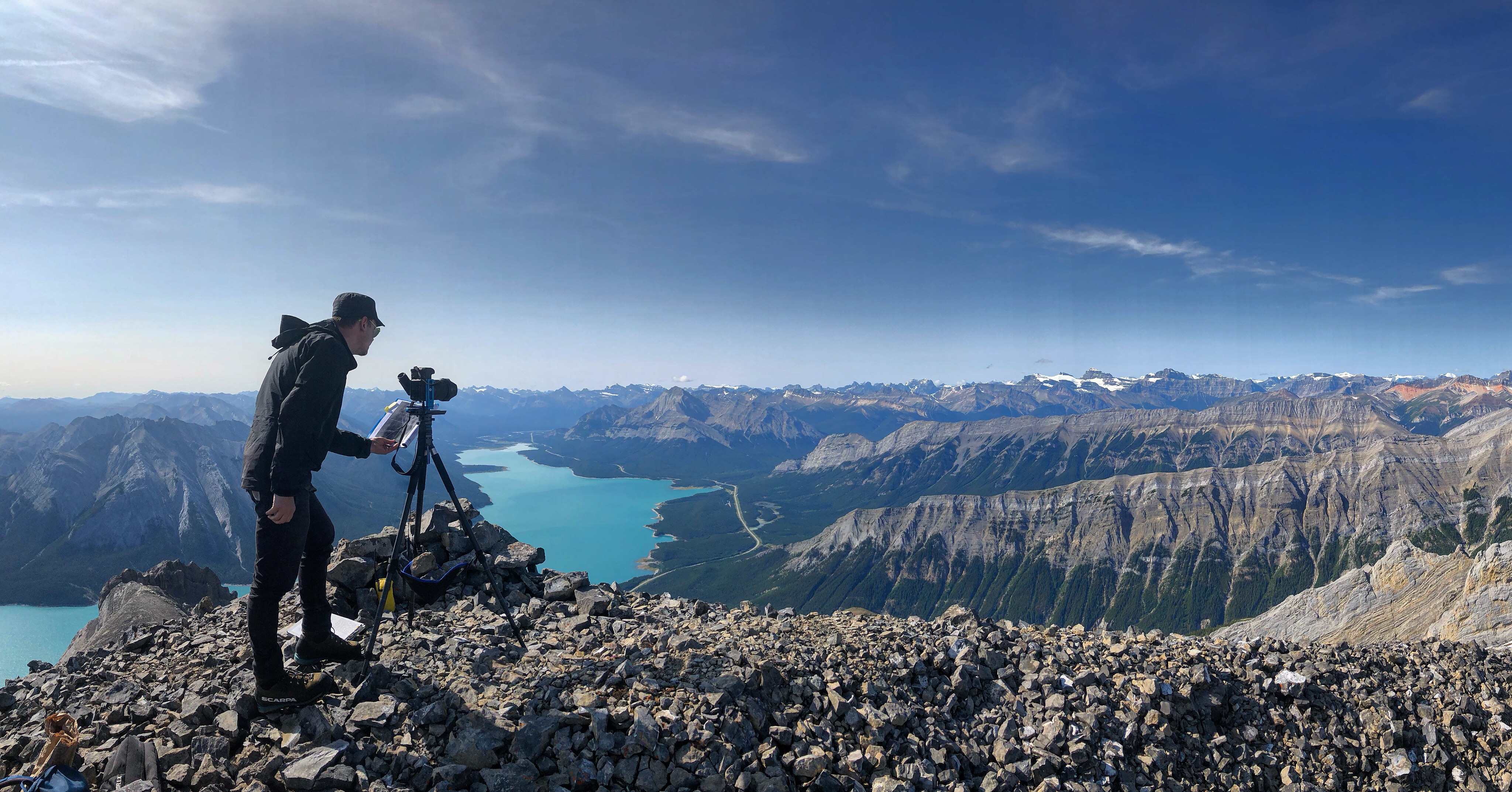WHO DO WE WANT TO BE HERE?
Reflections on an MLP season in the mountains
by Charles Hayes, Oct 1, 2019.
Charles B. Hayes is currently studying for a PhD in Philosophy at Michigan State University.
This research opportunity was funded by MSU’s Engaged Philosophy Internship Program (EPIP).
Our camera is pointed west toward the continental divide, secured and levelled on a large tripod straddling a lichen-covered cairn. Our gear is organized, but scattered about with rocks holding it down in the wind: steel clipboards, clear plastic binders of black and white photos, transit, GPS, portable weather reading instrument, topographical maps, and more camera equipment than any reasonable person would carry to this height. We are quiet, but quite a conspicuous presence for a lesser-travelled peak in Kananaskis Country, Alberta.
This was July 1st, Canada Day, and another group of hikers were out celebrating the land, holding the Maple Leaf flag for photos on the summit. They couldn’t help but ask, “Are you surveying something?”
Spending the summer working with the Mountain Legacy Project I had many opportunities to answer such questions and explain our work. This project, now going for over two decades, has taken up the herculean task of repeating the thousands of systematic photographs taken by early surveyors as they mapped the Canadian Rockies. Repeating these 100 year-old images provides a uniquely precise look at the patterns of ecological change and consistency over the last century of the Rockies. These comparative data are made public and have become an important resource for research of all kinds. More than this, the lives and methods of these early surveyors are things of wonder, and trekking in their footsteps yields an appreciation of their effort and skill as well as a much richer, embodied understanding of this immense mountain landscape.
Rather than belabour explanation, I hand the hikers the old images. They light up. It’s the photographs that excite the imagination. Immediately they start spinning around the summit, matching the black and white prints to their surroundings.
“There’s Burke Mountain! It’s just the same.”
“Well, look at that – there are far more trees now.”
“My goodness! Can you imagine travelling through here a hundred years ago?”
They turn back to me:
“Have you seen those two pictures showing how the Athabasca glacier is shrinking?” (A recent article in Discover Magazine highlighted this powerful image.)
“You bet, that was the Mountain Legacy Project also.”
Finally, a woman from the group steps forward and asks with a smile, “Well, are we taking care of our mountains?”
I’m interested in this last question: Are we taking care?
This might seem like a straightforward question. The photos show how the landscape has changed in the last century. So, has it changed for the better or for the worse? This kind of question is about the state of the land itself, about its health. Sometimes clear answers are available about the health of ecosystems, other times in quickly becomes complex and fraught. This hiker’s question, however, is already more complex than a question about the health of the land. There is another level to it. Instead of just the land, the question concerns the quality of human relationships with the land. Are we caring? This is a question about us, a question communities can ask about their own relationship with the land.
This brings important ethical considerations into focus in ways that questions only about the health of the land do not. These questions concern the quality of my relationship with my environment. What’s more, I don’t think it is at all coincidental that a comparison of historical images prompted such a reflexive question. As one pieces together the story of these images, trying to imagine all that has transpired between then and now, one is drawn to wonder about one’s own place in this story. What role have “we” played in this story? What kind of character am I?
Learning more about a place, becoming fascinated with it and wondering about one’s place within it, creates a connection. It tends to inspire care. It is worth looking more deeply at how fascination and wonder can inspire care, at how a fascination in the history of a place can strengthen and shape that care. The photographs of the Mountain Legacy Project open a door to this kind of historical wonder.
The Mountain Legacy Project started as a way of informing large ecological restoration projects. Being able to see and measure changes across a landscape provides unparalleled insight into ecological trends. It reveals how human practices have shaped ecology, sometimes dramatically, even in places often described as untouched.

On the lower slopes of Mt. Dungarvan, Waterton Lakes National Park. The MLP field team lines up a repeat photo of Mt. Anderson. Historic image from 1942 by surveyor A. C. Sheppard.
But how is a photograph, or even details of past ecological conditions supposed to inform ecological restoration? Eric Higgs, the founder of the Mountain Legacy Project, has long worried that ecological restoration can all too easily become a merely technical enterprise. As a technical enterprise, restoration is about designing landscapes along the same lines – that is, with the same underlying values and quality of relationships – as people design strip malls or theme parks. The guiding question of a technical restoration is only “What kind of landscape do we want to build?” rather than something deeper, like, “What kind of relationship do we want to have with this landscape?”
As professional restorationists become more skilled, and as the machinery of restoration becomes more powerful, it becomes easier and easier for the latter question to fade into the background. Enthralled by humanity’s growing ability to more efficiently alter and take control of our environments, little attention is paid to how this increase of control changes the quality of our different relationships to a place. In this age, what many are calling the Anthropocene, the overwhelming trend is towards increasing control, from taking control of the climate down to designing DNA.
In some ways this isn’t new. Some people say that Western science as a whole was founded solely on the quest for prediction and control. There is truth to this narrative, if not the only truth.
This mention of science brings up another story from the field. Our team had been staying in a Parks Canada backcountry patrol cabin, an eight kilometer walk into the woods – no internet, no electricity, just a sturdy wood stove and a whole ice-cold creek of fresh water. The essentials. There is history here. The cabin log-book is filled with grateful narratives of rangers who have rested here on their rounds, each one noting the weather, the water level, the plants in season, the animals seen, and each entry always adding a word of thanks that such a wild place exists.
During our stay at the cabin I was reading Jack Turner. As the team ate breakfast one morning I read out one of Turner’s stronger passages about the relation of science and wild places.
-
“We need big wilderness, big natural habitat, not more technological information about big wilderness. Why not work to set aside vast areas where we limit all forms of human influence: no conservation strategies, no designer wilderness, no roads, no trails, no satellite surveillance, no over-flights with helicopters … no guidebooks, no topographical maps. … Let wilderness again become a blank on the maps.” (The Abstract Wild, pg 120)
No matter the interests or motivations of the early surveyors in these mountains, Turner is right to highlight map making as a foundation for all the intervention and control of the land that comes after. The maps serve the railroads, the timber industry, the mineral industries, the highways, the ski resorts, and the ever-encroaching housing developments. And here I am, inspired by a love of wild places, helping to make more finely detailed maps, of a sort. To what use will these be put? Will the photos inspire the kind of fascination and concern I witnessed in the Canada Day hikers? Or, will they add to what Turner fears, diminishing what makes these places wild, changing the relationships people can have with wild spaces? Will this data foster wonder or facilitate control?
Turner’s suggestions can seem extreme. All the same, he isn’t talking nonsense when he fears that scientific research, and even conservation itself, can too easily feed the same technological juggernaut of my society’s continued exploitation and diminishment of wild places. So, what should I make of my own study of ecological history and the wonder that working with these old photographs inspires? I think there is a good model in the response of the Canada Day hikers, of history inspiring wonder, and wonder inspiring care.
What I’m calling wonder and control mark the difference between learning how the world works and learning to work the world. They’re miles apart, yet so precariously close together. To seek understanding, but to do so in ways that temper and even relinquish the will to increase control is to move against the tide of this age, the Anthropocene, but it is surely possible. It is made all the more possible when we place the technical, measurable questions of ecological research within much bigger questions, like, “Are we taking care?”
It takes a lot more to answer this kind of question. At its best, studying ecological history is one way of deeply asking just where are we? The vast age of these mountains has a lot to say about this. In answering this question, we can earnestly face another: just who are we? That is, what kind of people are we in relation to the land? Are we compassionate? Grateful? Or thoughtless and wasteful? This question is about the ethical quality of our relationships. The story of ecological change over the last century provides powerful and poignant testimony to just the kind of people we are, each of us with very different histories and roles in the dramatic changes of the last century. And answering this, the most important question becomes: who do we want to be here?
These questions can’t be answered with any historical baseline measurement or ecological model, and yet the history is precisely what can bring these questions to life, can push us to look at our lands and our own lives more deeply. The history and science enrich the space in which people can come together to think about these broader questions.
More Information
Higgs, E. (2003). Nature by Design: People, Natural Process, and Ecological Restoration. Cambridge: MIT Press.
Turner, J. (1996). The Abstract Wild. Tucson: University of Arizona Press.
Links to more images from the stations shown in this post:
Overlooking Lake Abraham: M. P. Bridgland, 1924
Sentinel Mountain: A. C. Tuttle, 1942
Sage Creek: M. P. Bridgland, 1914
Bull Creek Hills: A. C. Tuttle, 1942
Red Rock Station: A. C. Sheppard, 1914





